Related Research Articles
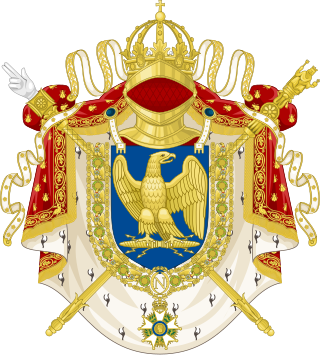
The House of Bonaparte is a former imperial and royal European dynasty of Corsican origin. It was founded in 1804 by Napoleon I, the son of Corsican nobleman Carlo Buonaparte and Letizia Buonaparte. Napoleon was a French military leader who rose to power during the French Revolution and who, in 1804, transformed the First French Republic into the First French Empire, five years after his coup d'état of November 1799. Napoleon and the Grande Armée had to fight against every major European power and dominated continental Europe through a series of military victories during the Napoleonic Wars. He installed members of his family on the thrones of client states, expanding the power of the dynasty.

The House of Hohenzollern is a formerly royal German dynasty whose members were variously princes, electors, kings and emperors of Hohenzollern, Brandenburg, Prussia, the German Empire, and Romania. The family came from the area around the town of Hechingen in Swabia during the late 11th century and took their name from Hohenzollern Castle. The first ancestors of the Hohenzollerns were mentioned in 1061.
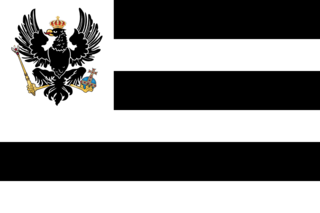
Hohenzollern-Sigmaringen was a principality in Southwestern Germany. Its rulers belonged to the senior Swabian branch of the House of Hohenzollern. The Swabian Hohenzollerns were elevated to princes in 1623. The small sovereign state with the capital city of Sigmaringen was annexed to the Kingdom of Prussia in 1850 following the abdication of its sovereign in the wake of the revolutions of 1848, then became part of the newly created Province of Hohenzollern.

The House of Medici was an Italian banking family and political dynasty that first consolidated power in the Republic of Florence under Cosimo de' Medici, during the first half of the 15th century. The family originated in the Mugello region of Tuscany, and prospered gradually until it was able to fund the Medici Bank. This bank was the largest in Europe during the 15th century and facilitated the Medicis' rise to political power in Florence, although they officially remained citizens rather than monarchs until the 16th century.

Christian I was a German noble and Scandinavian monarch under the Kalmar Union. He was king of Denmark (1448–1481), Norway (1450–1481) and Sweden (1457–1464). From 1460 to 1481, he was also duke of Schleswig and count of Holstein. He was the first king of the House of Oldenburg.

A coronet is a small crown consisting of ornaments fixed on a metal ring. A coronet differs from other kinds of crowns in that most coronets do not have arches, and from a tiara in that a coronet completely encircles the head, while a tiara does not.

The House of Nesselrode is a noble family originating in the Duchy of Berg. Over the centuries, the family expanded their possessions through marriage with the most powerful families of the region. As a former ruling family they belonged to the small circle of Uradel.

Johann Wilhelm II, Elector Palatine of the Wittelsbach dynasty was Elector Palatine (1690–1716), Duke of Neuburg (1690–1716), Duke of Jülich and Berg (1679–1716), and Duke of Upper Palatinate and Cham (1707–1714). From 1697 onwards Johann Wilhelm was also Count of Megen.
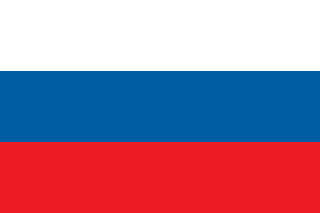
The Duchy of Carniola was an imperial estate of the Holy Roman Empire, established under Habsburg rule on the territory of the former East Frankish March of Carniola in 1364. A hereditary land of the Habsburg monarchy, it became a constituent land of the Austrian Empire in 1804 and part of the Kingdom of Illyria until 1849. A separate crown land from 1849, it was incorporated into the Cisleithanian territories of Austria-Hungary from 1867 until the state's dissolution in 1918. Its capital was Ljubljana.

The House of Schwarzenberg is a German (Franconian) and Czech (Bohemian) aristocratic family, and it was one of the most prominent European noble houses. The Schwarzenbergs are members of the German nobility and Czech nobility, and they held the rank of Princes of the Holy Roman Empire. The family belongs to the high nobility and traces its roots to the Lords of Seinsheim during the Middle Ages.

The Duchy of Florence was an Italian principality that was centred on the city of Florence, in Tuscany, Italy. The duchy was founded after Pope Clement VII, himself a Medici, appointed his relative Alessandro de' Medici as Duke of the Florentine Republic, thereby transforming the Republic of Florence into a hereditary monarchy.

The House of Limburg-Stirum, which adopted its name in the 12th century from the immediate county of Limburg an der Lenne in what is now Germany, is one of the oldest families in Europe. It is the eldest and only surviving branch of the House of Berg, which was among the most powerful dynasties in the region of the lower Rhine during the Middle Ages. Some historians link them to an even older dynasty, the Ezzonen, going back to the 9th century.

The coat of arms of Bavaria has greater and lesser versions.
The County of Rieneck was a comital domain within the Holy Roman Empire that lay in what is now northwestern Bavaria. It bore the same name as its original ruling family, the Counts of Rieneck, from whom the county and its main seat, the town of Rieneck, got their names.

Lorenzo Magalotti was an Italian philosopher, author, diplomat and poet.

The House of Hahn is an ancient German-Baltic noble family which was prominent in the Duchy of Courland and Semigallia and on the Baltic Island Ösel. It was founded in 1230. It is also part of the old Mecklenburg noble family, first mentioned on October 30th, 1230. The Mecklenburg clan branched out at the turn of the 14th century into a Mecklenburg and a Courland clan.

Gregorio (Goro) Dati was a Florentine merchant and diarist best known for the authorship of The Diaries of Gregorio Dati, which represents a major source for social and economic historians of Renaissance Florence, alongside the diaries of Buonaccorso Pitti. He kept a detailed diary outlining his business dealings as well as personal information about the births and deaths of his four successive wives and his 26 children.
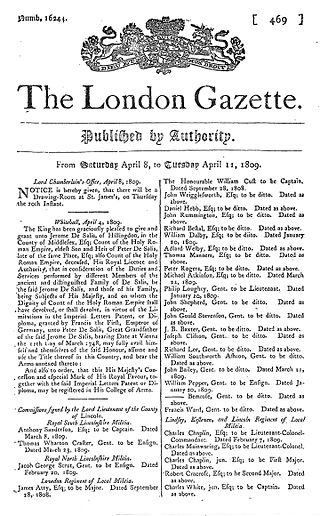
Count de Salis-Soglio is a continental title of nobility that was recognized in the United Kingdom for a Swiss family which became British Subjects when Jerome, 2nd Count de Salis, was naturalized by Private Act of Parliament in 1743.
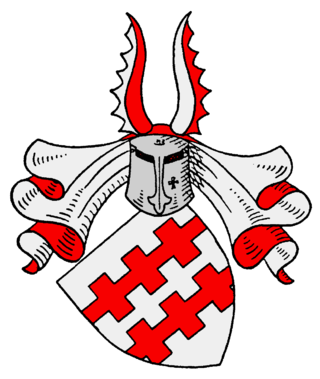
The Pranckh family is an ancient Austrian noble family, descending from Pranckh Castle, near Sankt Marein bei Knittelfeld in the former March and later Duchy of Styria. The family's origins date back to the year 1135, when Wolfkerus de Branka attested a charter regarding an endowment to Admont Abbey, thus making it one of the oldest families in Austria still present today. In addition to the Styrian mainline, other branches existed in Salzburg, Carinthia, Lower Austria and Bavaria. In later parts of history, the family rose from Knights to Reichsfreiherren (Barons of the Holy Roman Empire) and Reichsgrafen (Imperial Counts of the Holy Roman Empire). Many of their names can be found in high court and state offices of the Archbishopric of Salzburg. Branches of the family exist to this day in Austria, Germany, France and the United States.